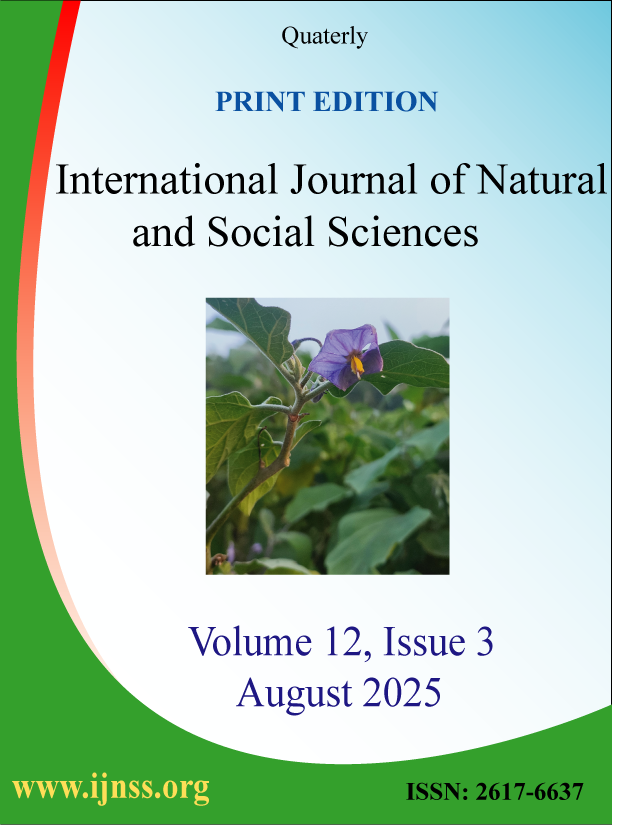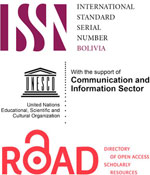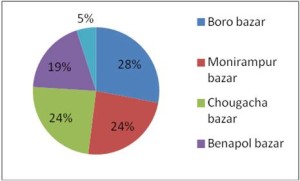Intensity of formalin misuse for fish preservation in five markets of Jessore district, Bangladesh
Lipi Paul1, Debashis Kumar Mondal2![]()
![]() , Mritunjoy Paul3, Mohammad Golam Sajed Riar3, Azhar Ali4
, Mritunjoy Paul3, Mohammad Golam Sajed Riar3, Azhar Ali4
1Extension Officer, Department of Fisheries, Jessore sadar, Jessore, Bangladesh
2Scientific Officer, Bangladesh Fisheries Research Institute, Freshwater Sub-station, Jessore
3Scientific Officer, Bangladesh Fisheries Research Institute, Freshwater Station, Mymensingh
4Scientific Officer, Bangladesh Fisheries Research Institute, Brackish Water Station, Paikgacha
ABSTRACT
The present study was conducted to investigate the intensity of formalin misuse in consumable fish species for preservation in five markets in Jessore district of Bangladesh. A total of 500 fish samples were collected to detect the presence of formalin in fish during January to September, 2014. Some of the freshwater fishes were local which were captured from the baors and nearby aquaculture project and some were imported from Myanmar and India while most of the marine fish came from the Chittagong. In the study area, formalin was found in 4.2% of total sampled fish. About 300 freshwater fish samples have been tested and among them 15% formalin treated fish was found. In case of marine fish sample, out of 200 samples, 10.50% formalin treated fish were found. Among marine fishes, 15% Ilish were found contaminated with formalin. The misuse of formalin was more in marine fishes from Chittagong and imported fishes from Mayanmar. Small Indigenous Species (SIS) was more formalin contaminated than large fish. Among 180 SIS samples, 18 formalin preserved fishes were found (10%) and out of 320 large fish samples, only 3 formalin preserved fishes were found (0.94%). Among the SIS, katchki (15% of katchki contaminated with formalin) and mola was found formalin contaminated. Among all the formalin treated fishes, the rate was found highest in Boro Bazar (28%) of sadar upazila and lowest in Jhikorgacha Bazar (5%). It was observed that fish sellers were affected by various types of skin disease, inhalation problem and eye irritation problem etc. who handle these formalin treated fish regularly. This study indicated that more or less the consumers of Jessore District are taking formalin through consumption of fish which is alarming both for consumers and retailers.
Key words: Formalin, fish, Barmij Rui, Katchki, Mola, Jessore
![]() Corresponding author. Tel.: +8801717659326
Corresponding author. Tel.: +8801717659326
E-mail address: debbfri@gmail.com (DK Mondal) Copyright@2014 Int. J. Nat. Soc. Sci. all right reserved.
INTRODUCTION
Bangladesh is a country of thousands of rivers crises-crossed throughout the country. From the time immemorial, fish and fisheries play a significant role in the economy of Bangladesh in terms of animal protein supply, employment, earning of foreign currency and poverty alleviation. Fish is the major source of food staff in the world and in respect of Bangladesh, fishes are considered as one of the main national foods. Fish is a highly perishable food item; hence quality of fish quickly deteriorated and the process is accelerated with increasing temperature owing to a number of factors such as microbial activity, oxidative reaction and self enzymatic activity. Therefore, to maintain quality fish needs proper care from the time it is caught until it is served or processed. Fish quality is a complex concept involving with some factors, freshness being one of the most important. Fresh fish means having its original quality unimpaired i.e. not deteriorated in any way. Depending upon the marketing and distribution channels, it takes several hours to several days to consume after catching or collecting from rivers or ponds. Therefore, it is highly essential to take proper step to preserve and maintain its quality until reach to the consumer. Icing is the most common practice of fish preservation in our country. Agents or wholesaler are not using adequate quantity of ice for short term preservation during transportation of large quantities of fish to more distant places, which leads to shortened shelf life of fish. Quality loss also occurs due to rough handling when the fishes are transported to market in iced condition by means of trucks, carrier launches and rail ways for short and long distance transport (Reza et al., 2009). As a result, fish lose its quality about 25% to 28% until it reaches to the consumer. Among the total fish production, one fourth become inedible in every year accounting uncountable losses to the traders and producers (DoF, 2011). Therefore, some bad traders are trying to apply harmful chemicals like formalin for fish preservation to make them stiff and appear fresher for long periods of time and to prevent decomposition. In Bangladesh, for the first time this formalin treated fishes were traced from the traders in 2006 during an operation against impure food of a mobile court led by Metropolitan Magistrate Rokon-Ud-Doula (Kausar, 2007).
A 37% formaldehyde solution, known as formalin, is an inexpensive and effective preservative that rapidly penetrates into the tissue. It is one of the most popular and commonly used preservatives for long time preservation of dead animal body including fish in museum, laboratories etc. Besides, it is widely used as a disinfectant in many human medicines and cosmetics and as an antiseptic in veterinary drugs and biological and in fungicides, textiles and embalming fluids (Feick et al., 2006). The use of formalin in fish to increase the shelf life is very harmful to human health. On 10 June 2011, the US National Toxicology Program has described formaldehyde as “known to be a human carcinogen”. Formaldehyde is irritating to tissues when it comes into direct contact with them. The most common symptoms comprise irritation of the eyes, nose, and throat, along with increased tearing, which occurs at air concentrations of about 0.4–3 parts per million (ppm). Formaldehyde is immediately dangerous to life and health at 20 ppm. One large study of people with asthma found that they may be more sensitive to the effects of inhaled formaldehyde than other people. Severe pain, vomiting and possible death can occur after taking large amounts of formaldehyde. Skin can become irritated if it comes into contact with a strong solution of formaldehyde. Consumption of formalin preserved fish may cause uncontrolled cell growth or cancer in any part of body like stomach, lung and respiratory system (Ross et al., 2002). Besides, inhalation of formaldehyde causes respiratory system cancer (Marsh et al., 2007). With the aforesaid discussion, this study will help to make awareness of fish consumer in Jessore district during buying of fishes from fish market.
MATERIAL AND METHODS
Samples were taken once from each market in a week and every sampling day, 7-8 samples of most available species were randomly selected during the study period. Thus, from each market, 100 fish samples were collected and a total of 500 fishes were testing among which 200 were marine and 300 were freshwater fishes. Fish samples were washed by little amount of water and washed water collected into the test tube/vial. In case of small fish, the individual fish were packaged in small polythene bags and then preserved in ice box. Sometimes fish scale, gill and fin were also collected and brought to the laboratory for testing. Formalin detection kit developed by Bangladesh Council of Science and Industrial Research (BCSIR) was used in this experiment. Formalin was detected according to the manufacturer instruction. The kit contained three solutions. At first, the fish samples were washed with small quantity of water and 2.5ml of washed out water was taken in a test-tube using a dropper included in the kit. Then 15 drops from solution No.1 was added in the test tube containing washed out water and after well stirring, the solution was allowed to wait for 30 second. After thirty seconds 15 drops from solution No.2 was added in the same test tube and after well stirring, the solution was allowed to wait for 30 second. Then 15 drops from No. 3 solution was added in the same test tube, if the color of the solution changed into pink or red color, it indicated the presence of formalin (qualitative only). Unchanged color of the solution indicated no formalin in the sample.
RESULT AND DISCUSSIONS
The list of fish samples were tested for formalin detection is shown in Table.1
Table1
Name of the species sampled and their source & status of formalin contamination from different fish markets of Jessore district.
| Serial No. | Local name of fish | Scientific name of fish | Source | Formalin |
| 1 | Rui | Labeo rohita | Local | Absent |
| 2 | Catla | Catla catla | Local | Absent |
| 3 | Indian rui | Labeo rohita | Imported fish | Absent |
| 4 | Indian catla | Catla catla | Imported fish | Absent |
| 5 | Barmij rui | Labeo rohita | Imported fish | Present |
| 6 | Barmij catla | Catla catla | Imported fish | Absent |
| 7 | Illish | Tenualosa illisha | Other districts | Present |
| 8 | Kachki | Corica soborna | Other districts | Present |
| 9 | Mola | Amblypharyngodon mola | Local | Absent |
| 10 | Mrigal | Cirrhinus cirrhosus | Local | Absent |
| 11 | Kalibaus | Labeo calbasu | Local | Absent |
| 12 | Tilapia | Oreochromis mossambique | Local | Absent |
| 13 | Bata | Labeo bata | Local | Absent |
| 14 | Carpio | Cyprinus carpio | Local | Absent |
| 15 | Parse | Liza persia | Local | Absent |
| 16 | Bighead carp | Aristichthys nobilis | Local | Absent |
| 17 | Silver carp | Hypophthalmichthys molitrix | Local | Absent |
Formalin in consumable fish
During the study, a total of 21 formalin treated fishes which accounts 4.2% of the total examined fishes (500 samples) were found in Jessore district. The result is in conformity with the study of Haque and Mohsin (2009) where 50 formalin treated fishes among 800 surveyed samples were formalin positive (5%) in Dhaka city. In Dhaka city, maximum fishes were coming from different districts. Results showed that intensity of formalin use in Jessore district is nearly similar to the Dhaka city. Similarly in our study a good amount of fishes are produced by local aqua farms or captured from different rivers and baors in Jessore district but many fishes also coming from outside of the district.
Formalin in marine water versus freshwater fish
In the study, 300 freshwater fish samples were tested and among them 45 fishes were treated by formalin which occupies 15%. In case of marine fish samples, out of 200 samples, 21 formalin treated fish which accounts 10.5%. Formalin was found in Kachki, Mola and Barmij Rui which consist of 15% of freshwater fish species. Formalin was found in 10.50% of marine water fish. Formalin was found only in one sample of Ilish. Some freshwater fishes available in the domestic market were produced locally but the fishes were come from outside usually contaminated with formalin. Yeasmin et al., (2010) showed that formalin was not detected in any fish produced locally. All of the Barmij rui and Kachki which came from Chittagong were contaminated with formalin. On the contrary, other fish species were formalin free.
Formalin in Barmij rui versus Kachki
In the present study, out of 20 samples of Barmij rui 18 fish (90%) of the samples were contaminated with formalin which were came from Mayanmar via Chittagong. Wheras local rui fishes were free from formalin while 15% of total Kachki sample were formalin positive indicating that intensity of misuse of formalin was more in Barmij rui than Kachki. Although both Barmij rui and Kachki are freshwater fish, Barmij rui come from Mayanmar and takes huge time to reach consumer table which makes it more vulnerable to microbial attack and hence it spoils quickly. The demand to the consumers of this fish was high. Therefore, the fish traders used formalin in Barmij rui for increasing shelf life of the fish to supply and meet up the demand of consumers. On the other hand, Kachki is a small fish and also demandable fish. Some Kachki were come from nearby districts and some from distant part of the country and the traders used the ice box for preservation. So, the tendency of misuse of formalin was more in Barmij rui than Kachki.
Formalin contamination in SIS versus large fish
Formalin contamination was more in small indigenous species (SIS) than large fish. Among 180 SIS samples, 10% formalin preserved fishes were found and 0.94% formalin preserved large fish samples were found. Usually SIS is more vulnerable to spoilage due to their body physiology and the demand of SIS is higher than large fish. Therefore, the bad traders were more interested in misuse of formalin in SIS than large fish. Among SIS samples, kachki and mola were contaminated with formalin. Katchki comes from distance places like Chittagong is more vulnerable to microbial attack, therefore, it requires more attention to keep it fresh. Furthermore, it is a very popular fish throughout the country due to its taste. Therefore, both retailers and transporters have a fascination to use formalin to this fish. The study is in accordance with the study of Haque and Mohsin (2009) who found 10.25% formalin preserved large fishes and 2.25% SIS samples were found formalin treated. Large formalin affected fishes were dominated by Indian major carps specially Rohu (Labeo rohita) 44% of the total formalin treated fishes and it was followed by Catla (22%) and Mrigal (6%), respectively. On the other hand for SIS species small shrimp, kachki, bele and others were found 6%, 6%, 2% and 4%, respectively. This difference is probably due to the sources of fishes, from where they are coming from.
Formalin contamination in five markets
Five markets named Boro bazar (sadar upazila), Jhikorgacha fish market, Monirampur bazar fish market, Chougacha bazar fish market, Benapol bazar fish market, were selected for testing of formalin contamination in consumable fish. Among those markets, maximum numbers of the formalin treated fishes were found in Boro bazar while minimum numbers of formalin treated fish were found in Jhikorgacha Bazar. Only in Boro bazar and Monirampur Bazar, formalin contaminated ilish were found (Fig. 1).
Figure1
Percentage of formalin contaminated fishes found in different fish markets.
During the study, availability of formalin treated fishes in five fish markets was also varying in different fish markets of the Jessore sadar upazila and Monirampur upazilla.The percentage of the formalin treated fish in five markets, i.e Boro bazar (sadar upazila), Monirampur bazar fish market, Chougacha bazar fish market, Benapol bazar fish market and Jhikorgacha fish market were 28%, 24%, 24%, 19% and 5%, respectively. Maximum formalin contaminated fish were found in Boro bazar (sadar upazila) (28%) and lowest in Jhikorgacha fish market (5%). According to Haque and Mohsin (2009) among the four fish markets of Dhaka city (Kawran Bazar fish market, Savar Bazar fish market, Mirpur Bazar fish market and Jatrabari fish market) the highest percentage of formalin treated fishes were found in Kawran Bazar fish market (48%) and lowest in Savar Bazar fish market (14%). In the study area, among the fish markets Boro bazar (sadar upazila) was the largest raw products’ market for whole sale and retail sale. In this market, imported fish such as Barmij rui, Barmij catla and other species of fish were also available and came from the Chittagong. In Jhikorgacha fish market, size and variation of fish species was less. The percentage of formalin contaminated fish of Monirampur bazar fish market, Chougacha bazar fish market and Benapol bazar fish market were more or less similar.
Formalin contamination in imported fish in Jessore
In Bangladesh, imported fish are coming from India and Myanmar. Indian rui, Indian catla, Barmij rui, Barmij catla are available in Boro bazar (sadar upazila) and Benapol bazar fish market in Jessore. Except Barmij rui formalin was not found in any of the imported fish.
Present study showed that formalin was not found in all imported fishes. Yeasmin et al., (2010) found that formalin was detected in the imported Catla and Rohu ranging from 0.5% to 1% which were sold in different markets of Mymensingh with comparatively lower price than those produced locally. In our study imported fishes were found in only two fish market named Boro bazar (sadar upazila) and Benapol bazar fish market out of five markets. The imported fish were distributed in whole country from the Chittagong. The fish traders of the imported fish were very careful about transportation of the imported fish from Mayanmar and India to Jessore. The traders used specialized ice box for transportation of the imported fish. Kausar (2007) revealed that the imported fish which were come from Mayanmar and India did not contaminated by formalin in the landing centre of Chittagong. However, the detection of formalin in the local market indicating the contamination of formalin by either during transportation or during selling in local market.
Formalin in morning or evening market
Among the five fish markets, Boro bazar (sadar upazila), Monirampur bazar fish market were sit in the morning and Chougacha bazar fish market, Benapol bazar fish market and Jhikorgacha fish market. Fish samples are collected both morning and evening from the fish market. In the study, maximum formalin treated fish were found in the morning.
Meherunnesa (2008) observed that more formalin positive samples were found in the fish sampled in the evening than those collected early in the morning in Dhaka fish markets. In the study area, maximum fishes were local and fishes which were captured from rivers or aqua farms came in morning and sold within the noon. For evening fish market fish were captured in the noon which were marketing in the fish market and sold within few hours. All formalin positive fishes were come from outside of the district and they reached in the morning and sold before evening. So, formalin was found more in morning than evening.
Skin diseases among fish sellers
It is observed that most of the Barmij rui sellers are affected by the various types of skin diseases. Few ilish fish sellers are also affected by the skin diseases. Present study showed that the fish sellers who handled the formalin contaminated fish were suffered from various skin disease and inhalation problem. The study is supported by the study of Meherunnesa (2008) who found that skin, inhalation and eye irritation problem were seen among the fish sellers. In Jessore, the most formalin treated fishes were found in Barmij rui and kachki. Since formalin is harmful to the human body, monitoring and surveillance system should be actived to detect and dispose of the formalin treated fish in order to prevent this illegal trade.
REFERENCES
DoF (Department of Fisheries), 2011. Saranica, Matsya Pakhya Sankalan, Ministry of Fisheries and Livestock. The Government of Peoples republic of Bangladesh, Dhaka.
Feick P, Haas SRL, Singer MV and Ocker UB (2006). Low-dose exposure of intestinal epithelial cells to formaldehyde results in MAP kinase activation and molecular alteration of the focal adhesion protein paxillin. Toxicology, 219: 60-72.
Haque, E and Mohsin ABM (2009). Intensity of Formalin Use for Consumable Fish Preservation in Dhaka City, Bangladesh. Journal of Fisheries International, 4: 52-54
Kausar IA (2007). About 80,000 kg formalin fish enter country every day: No policy for fish import yet. A Report Published in Daily Star.
Marsh GM, Youk AO, Buchanich JM, S Erdal and Esmen NA (2007). Work in the metal industry and nasopharyngeal cancer mortality among formaldehyde-exposed workers. Regulatory Toxicology and Pharmacology, 48: 308-319.
Meherunnesa (2008). Formalin use in Dhaka fish markets. Aculture news, 34.
Reza MS, Bapary MAJ, Ahasan CT, Islam MN and Kamal M (2009). Shelf life of several marine fish species of Bangladesh during ice storage. Int. J. Food Science Technology, 44: 1485–1494.
Ross PF, Draayer H and Itoh O (2002). An international collaborative study on a method for determination of formaldehyde in veterinary vaccines. Biologicals, 30: 37-41.
Yeasmin T, Reza MS, Khan MNA, FH Sikha and Kamal K (2010). Present status of marketing of formalin treated fishes in domestic markets in mymensingh district in Bangladesh. International Journal of Biological Research. 1(4): 21-24.







